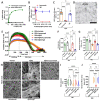This is a preprint.
Lecanemab Blocks the Effects of the Aβ/Fibrinogen Complex on Blood Clots and Synapse Toxicity in Organotypic Culture
- PMID: 38293058
- PMCID: PMC10827200
- DOI: 10.1101/2024.01.20.576458
Lecanemab Blocks the Effects of the Aβ/Fibrinogen Complex on Blood Clots and Synapse Toxicity in Organotypic Culture
Update in
-
Lecanemab blocks the effects of the Aβ/fibrinogen complex on blood clots and synapse toxicity in organotypic culture.Proc Natl Acad Sci U S A. 2024 Apr 23;121(17):e2314450121. doi: 10.1073/pnas.2314450121. Epub 2024 Apr 15. Proc Natl Acad Sci U S A. 2024. PMID: 38621133 Free PMC article.
Abstract
Proteinaceous brain inclusions, neuroinflammation, and vascular dysfunction are common pathologies in Alzheimer's disease (AD). Vascular deficits include a compromised blood-brain barrier, which can lead to extravasation of blood proteins like fibrinogen into the brain. Fibrinogen's interaction with the amyloid-beta (Aβ) peptide is known to worsen thrombotic and cerebrovascular pathways in AD. Lecanemab, an FDA-approved antibody therapy for AD, shows promising results in facilitating reduction of Aβ from the brain and slowing cognitive decline. Here we show that lecanemab blocks fibrinogen's binding to Aβ protofibrils, normalizing Aβ/fibrinogen-mediated delayed fibrinolysis and clot abnormalities in vitro and in human plasma. Additionally, we show that lecanemab dissociates the Aβ/fibrinogen complex and prevents fibrinogen from exacerbating Aβ-induced synaptotoxicity in mouse organotypic hippocampal cultures. These findings reveal a possible protective mechanism by which lecanemab may slow disease progression in AD.
Keywords: ARIA; Alzheimer’s disease; Biological Sciences/Neuroscience; NAS section: Biochemistry; amyloid-beta; fibrinogen; fibrinolysis; lecanemab.
Conflict of interest statement
Competing Interests: The authors have no competing interests.
Figures


References
-
- Karran E., De Strooper B., The amyloid hypothesis in Alzheimer disease: new insights from new therapeutics. Nat Rev Drug Discov 21, 306–318 (2022). - PubMed
Publication types
Grants and funding
LinkOut - more resources
Full Text Sources
